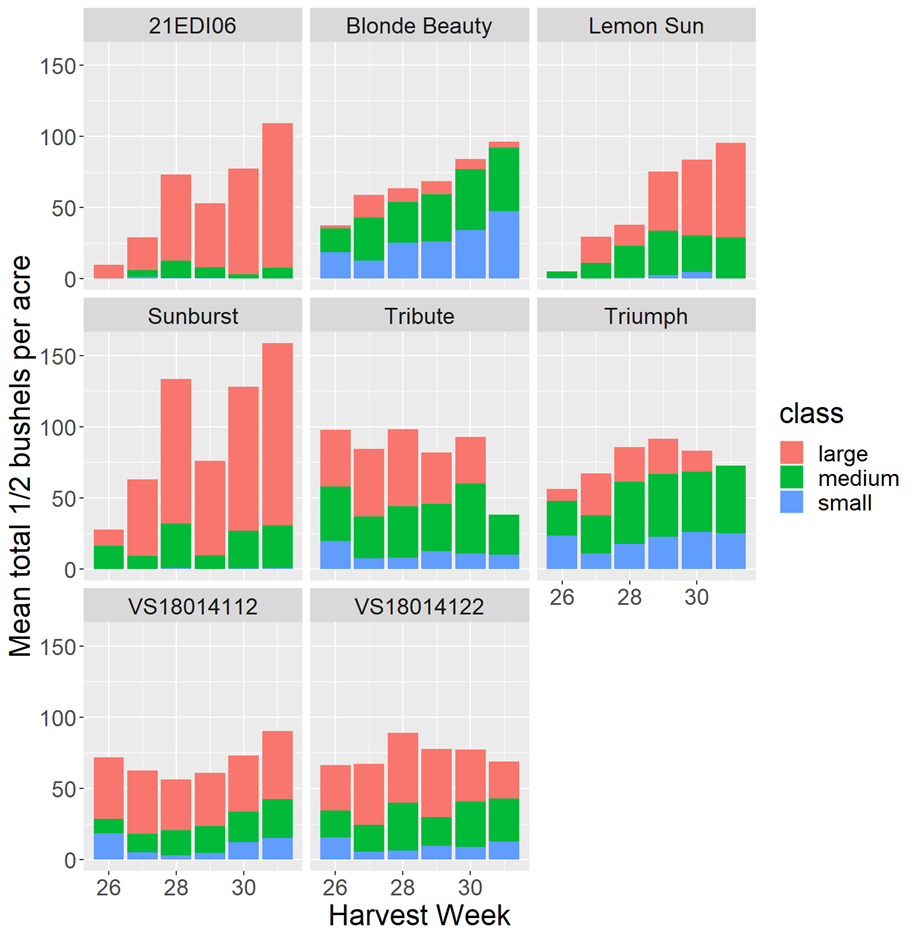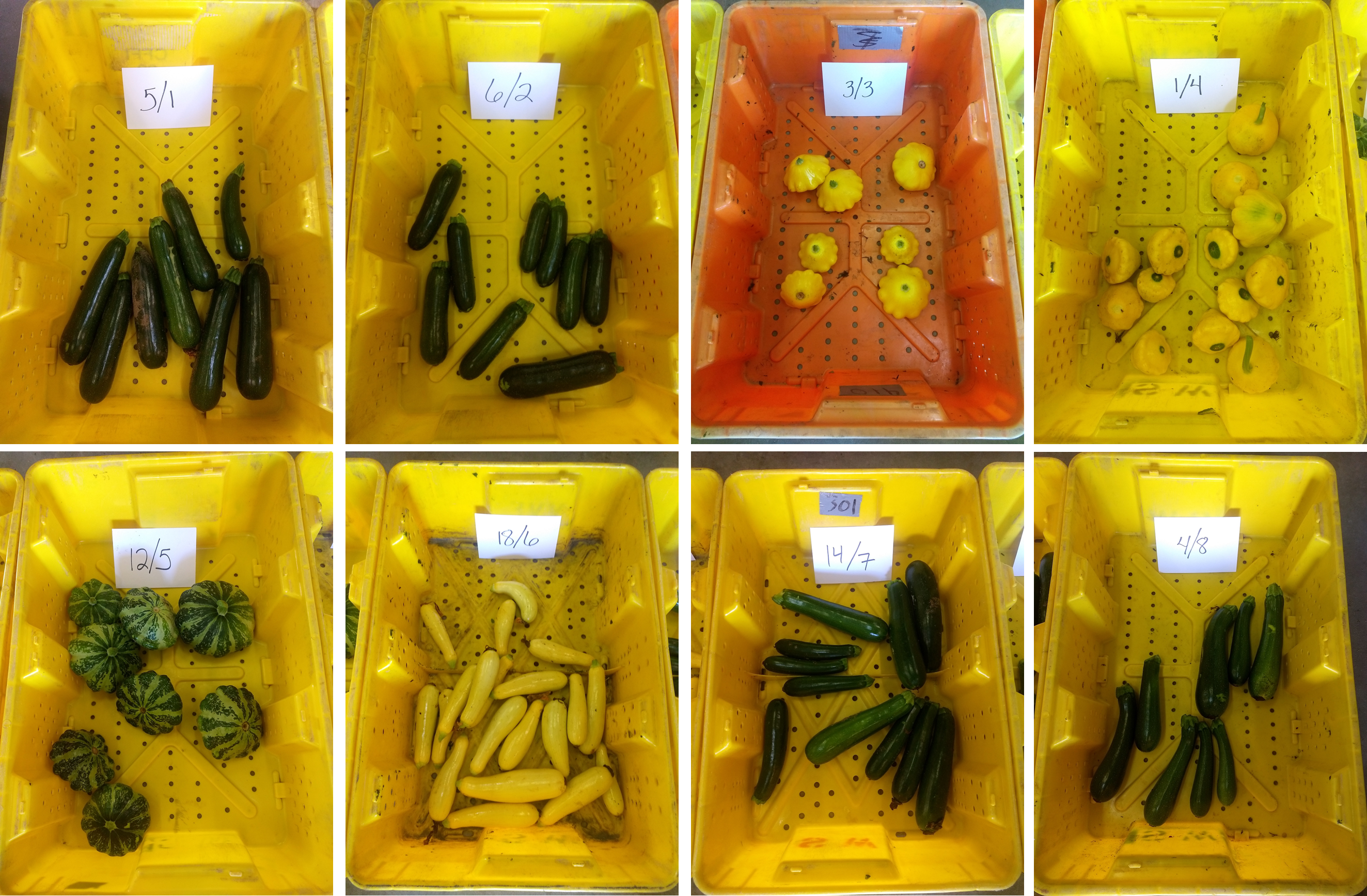
2022 Summer Squash Cultivar Trial
DOWNLOADDecember 7, 2022 - Benjamin Phillips and Jenny Schoonmaker, Michigan State University Extension
A summer squash cultivar trial was planted at the Southwest Michigan Research and Extension Center (42.081985, -86.354087, Benton Harbor, Michigan). HM Clause (HM), PanAmerican (PA), Rupp (RP), Sakata (SK), and US Agriseeds (UA) seed companies donated four zucchini cultivars, three patty pan cultivars, and one yellow summer squash cultivar for plastic-mulch bedded hand harvest. Trial quality was excellent.
Materials and Methods
On 29 April lime and fertilizers were preplant incorporated to achieve 40 lb. N, 0 lb. P2O5, 20 lb. K2O, 1 lb. B, 25 lb. S, and 2000 lb. lime per acre (119 lb. 21-0-0-21S, 32 lb. 46-0-0, 28 lb. 0-0-60, 6.5 lb. 0-0-0-15B) in a field size of 0.4 acre. The soil type was a well-drained Oakville fine sand. On 11-12 May, black plastic mulch and drip tape was laid with 6 ft between beds. No fumigation was used.
On 19 May, squash was seeded in a completely randomized design with four replications, one row per bed, 24 inches between holes in-row resulting in 8 plants per bed and a final plant population of 3,630 plants per acre. Two plants of a distinctly different variety were planted on either end of each plot to reduce picking errors between plots.
On 2 June, the fertigation schedule started delivering 7 lb. N and 13 lb. K2O per week (37 lb. 18-0-0-5Ca-1.5Mg, 22 lb. 0-0-60) for 6 weeks. No herbicides were applied. The field was hand-hoed, and diseases were managed with a weekly rotation of standard fungicides. Squash bugs were treated on 22 July.
Four reps of all cultivars were harvested and measured fourteen times on 1 Jul (43 dap), through 3 Aug (76 dap). We harvested all 8 plants from each plot when the fruits began reaching marketable sizes. Zucchini and yellow summer squash fruits were removed from the plants and sorted, counted, and weighed in the following categories: small (<6 inches long), medium (6 – 8 inches long), large (>8 inches long), and culls. Patty pan fruits were sorted, counted, and weighed in the following categories: small (<2 inches wide), medium (2 – 3 ½ inches wide), large (3 ½ – 5 inches wide), and culls. Culls consisted of any fruit that had blossom end rot, or was misshapen through crookedness, stubbiness, bulbousness, and – in the case of patty pans – if they were >5 inches wide. Nothing was counted as No. 2 quality. Yield data was analyzed with a both parametric ANOVA and non-parametric Kruskal-Wallis procedures followed by a Least Significant Difference (LSD) calculation.
The data was subset to compare zucchini, patty pans, and yellow summer squash cultivars. Fruit per plant, ½ bushels per acre of each size class, and combined total ½ bushel per acre yield calculations do not include culls. We determined ½ bushels per acre with the following equation.

Results and Discussion
The season was characterized by warmth and dryness (Table 1). The established stand was near 100%, and plants grew well. A few plots lost a plant or two from squash vine borers as the season progressed.
Zucchini
Total clean yield (small + medium + large) averaged 1080.7 ½ bushels per acre (Table 2), with Tribute and VS18014112 having the most consistent weekly volume (Figure 1). The top yielder was Tribute, which had over 500 ½ bushels per acre of both large and medium fruit.
Cull rates averaged 15% and were between 2% and 34%. The culls were largely due to crookedness and blossom end rot. The cultivar with the lowest cull percentage and highest number of marketable fruit was Triumph at 2% cull and 14.1 fruit per plant. The data suggests that Triumph sizes more slowly and resulted in more picks in the small and medium size classes than any other cultivar when picked every two days. Harvesting every third day may be a better picking schedule for this cultivar to fill more boxes with larger fruit. The cultivar with the highest cull percentage was VS18014112 at 34%.
Patty Pan
Total clean yield (small + medium + large) averaged 968.7 ½ bushels per acre (Table 3), and generally consisted of large fruit across each week of picking (Figure 1). These varieties sized quickly, and were often of a marketable small size before flowers had even opened. In general, these cultivars showed no signs of slowing, and could have continued with more picking. The top yielder by a wide margin was Sunburst.
Cull percentages averaged 15%, and were largely due to oversizing beyond 5 inches wide. This was especially the case for green and white striped cultivar 21EDI06 which yielded over double the volume of oversized culls than other cultivars with a rate of 32%. The angle of the scalloping on this variety was nearly perpendicular to the fruit length, which gave them more of a disk shape than the other patty pans in this trial. Sunburst (11% cull) and Lemon Sun (1% cull) both angled their scalloping downwards like Pacman ghosts and stayed within the marketable size range of 5 inches wide.
Yellow Summer Squash
The single entry for this subtype of summer squash is summarized in Table 4. Blonde Beauty performed similar to the zucchini submitted in this trial, and like the zucchini cultivar Triumph, it appeared to size more slowly, with mediums and smalls taking up a higher proportion of the total yield. A three- or four-day picking schedule may suit this cultivar better for to fill more boxes with larger fruit. This cultivar showed no signs of slowing, and could have continued with more picking (Figure 1).
Acknowledgements
Thanks to Steve Coffey, Cheni Filios, Ryan Kingma, Barry Rupp, and Dennis Thome at the seed companies; Dave, Rich, Sylvia, Martin, Mina, Ramon, and Jenny at the farm; and George McManus for technical review.
|
Table 1. Weather data summarized by weeks between 19 May and 5 Aug at the Southwest Michigan Research and Extension Center in 2022. Temperatures were averaged by week, and precipitation is total number of inches received for that week. *Week is reported as week of the year (week of the trial). |
|||||
|
Week* |
Max Air Temp (F) |
Min Air Temp (F) |
Max Soil Temp (F) |
Min Soil Temp (F) |
Precipitation (inches) |
|
20(1) |
71.3 |
51.2 |
71.5 |
59.8 |
0.5 |
|
21(2) |
72.5 |
51.4 |
72.5 |
59.4 |
0.3 |
|
22(3) |
79.9 |
56.3 |
79.3 |
65.3 |
0.0 |
|
23(4) |
72.3 |
53.9 |
76.0 |
63.6 |
1.0 |
|
24(5) |
85.8 |
62.4 |
86.7 |
71.6 |
1.1 |
|
25(6) |
84.8 |
61.3 |
89.4 |
72.4 |
0.0 |
|
26(7) |
82.1 |
57.2 |
90.7 |
71.4 |
0.0 |
|
27(8) |
84.5 |
64.0 |
87.8 |
73.2 |
2.7 |
|
28(9) |
79.9 |
60.3 |
85.6 |
72.8 |
0.1 |
|
29(10) |
85.2 |
68.9 |
86.1 |
75.2 |
0.4 |
|
30(11) |
- |
- |
- |
- |
- |
|
31(12) |
81.3 |
69.5 |
83.6 |
74.6 |
0.2 |
|
Mean |
79.2 |
57.5 |
82.2 |
67.7 |
0.6 |

|
Tables 2, 3, 4. Mean yield data of 8 summer squash cultivars, subset by their types, at the Southwest Michigan Research and Extension Center in 2022. Data in these tables are arranged in order of largest mean total yield in clean bushels per acre (large + medium + small), with a 1/2 bushel representing 20 lb. of summer squash. Analyses were not performed on the yellow summer squash subtype because there was only one cultivar submitted. Values in bold indicate the cultivar performed statistically like the cultivar with the highest value for that column. Numbers in parentheses are rank-sum values generated through the Kruskal-Wallis procedure used to analyze data that did not meet the assumptions for performing an ANOVA procedure. The Least Significant Difference (LSD) is the critical value that differentiates cultivars statistically. For example, subtracting the Total 1/2 bushels per acre LSD of 230.2 from Sunburst – 1353.4 – is 1123.2. Any cultivar with a rank-sum less than 1123.2 is deemed significantly different from Sunburst. In a column with rank-sums in parentheses, the same process is used with those parenthetical values. |
|
Table 2. Zucchini |
||||||
|
Company and Cultivar |
Total 1/2 bu/a |
Large 1/2 bu/a |
Medium 1/2 bu/a |
Small 1/2 bu/a |
Cull 1/2 bu/a |
Fruit Per Plant |
|
HM Tribute |
1223.2 |
544.2 |
518.8 |
160.1 |
115.5 (7.0) |
13.7 |
|
SK Triumph |
1101.3 |
266.7 |
540.2 |
294.4 |
25.0 (3.0) |
14.1 |
|
UA VS18014122 |
1068.0 |
577.3 |
360.6 |
130.2 |
176.5 (9.5) |
12.3 |
|
UA VS18014112 |
930.3 |
560.2 |
248.0 |
122.0 |
485.7 (14.5) |
9.6 |
|
Mean |
1080.7 |
487.1 |
416.9 |
176.7 |
200.7 |
12.4 |
|
CV |
16.1 |
37.5 |
32.8 |
45.2 |
104.3 |
17.9 |
|
Test stat (3,12) |
F=2.5 |
F=4.4 |
F=17.9 |
F=16.6 |
H=12.3 |
F=7.6 |
|
P-value |
0.110 |
0.027 |
0.000 |
0.000 |
0.007 |
0.004 |
|
LSD (t.students α=0.05) |
ns |
217.9 |
100.6 |
60.7 |
(3.5) |
2.3 |
|
Table 3. Patty Pan |
||||||
|
Company and Cultivar |
Total 1/2 bu/a |
Large 1/2 bu/a |
Medium 1/2 bu/a |
Small 1/2 bu/a |
Cull 1/2 bu/a |
Fruit Per Plant |
|
Sunburst |
1353.4 |
1064.7 |
282.7 |
6.0 |
162.6 (6.1) |
13.5 |
|
PA 21EDI06 |
797.5 |
706.1 |
84.9 |
6.5 |
376.8 (10.0) |
7.3 |
|
PA Lemon Sun |
755.2 |
431.1 |
295.3 |
28.8 |
6.1 (3.4) |
10.5 |
|
Mean |
968.7 |
734.0 |
220.9 |
13.8 |
181.8 |
10.4 |
|
CV |
32.3 |
43.3 |
52.5 |
134.6 |
104.7 |
26.4 |
|
Test stat (3,12) |
F=21.5 |
F=12.0 |
F=13.7 |
H=3.1 |
H=6.8 |
43.300 |
|
P-value |
0.000 |
0.003 |
0.002 |
0.209 |
0.033 |
0.000 |
|
LSD (t.students α=0.05) |
230.2 |
293.6 |
102.1 |
ns |
(3.9) |
1.5 |
|
Table 4. Yellow Summer |
||||||
|
Company and Cultivar |
Total 1/2 bu/a |
Large 1/2 bu/a |
Medium 1/2 bu/a |
Small 1/2 bu/a |
Cull 1/2 bu/a |
Fruit Per Plant |
|
RP Blonde Beauty |
937.0 |
118.0 |
451.1 |
367.9 |
79.2 |
15.5 |




 Print
Print Email
Email
